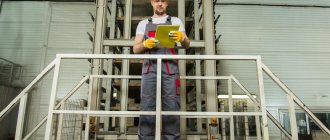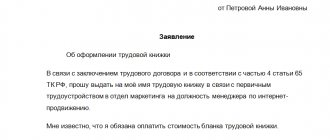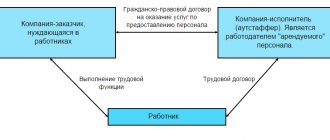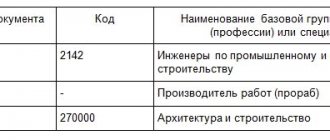Home / Labor Law / Personnel Management / Personnel training and certification
Back
Published: 08/09/2016
Reading time: 7 min
0
756
The Constitution gives citizens of the Russian Federation not just the right to get a job, but also the opportunity to carry out work in decent conditions that meet all basic safety and sanitary requirements.
Ensuring such conditions is one of the main responsibilities of any employer imposed on it by labor legislation.
In order to verify the compliance of the workplaces equipped by the employer with the basic requirements, the state conducts regular certification of all persons engaged in commercial and production activities, with the exception of individuals who have organized private business activities and are individuals.
- Legislation
- Goals and criteria for certification
- Requirements for inspectors
- Order of conduct
- How are the results presented?
- What should the employer do after receiving the results?
Certification, what is it
This concept is from the section of labor legislation. Denotes the identification of compliance of the environment and other factors at a person’s place of work with labor safety standards, for harmful and dangerous indicators.
If these factors are detected, the employer is obliged to develop an algorithm of actions to bring working conditions closer in accordance with these standards.
The phrase “job certification” was actively used until 2013; already in 2014, the definition of “special assessment” came to replace it.
The very concept and rules for its implementation are supported by Federal Law No. 426 of December 28, 2013. The main thing in this action is a set of techniques for detecting and assessing the harmfulness and danger of production indicators and the degree of their impact on human health.
Why is certification needed and is it needed at all? This procedure is carried out to divide all production factors into classes and subclasses according to the degree of negative impact on human health.
This division plays a big role in the lives of many workers. Employees engaged in the labor process with negative working conditions can count on a reduction in their length of service in order to receive a pension and receive benefits.
Certification allows you to give a full assessment of each workplace from several sides, its goals:
- Assess the degree and level of how factors in the working environment influence a person.
- Identify the severity and intensity of individual production cycles on the employee’s health.
- Determine the level of injury and its safety.
- Determine the provision of special clothing for each hired employee for life-threatening jobs.
The result of such an assessment is the completion of a certification card, which forms the basis for the development of measures to reduce injuries at the enterprise.
General section
Step 1. Identify the purpose of the certification
For one employer, it will be enough to write that the purpose of this event is to determine the compliance of the employee’s qualifications with the position he occupies.
Another may set out the goal of rational use of the labor resources of their employees, increasing the productivity of their work and responsibility for the assigned work. Formulate clearly and specifically exactly the goal you are trying to achieve.
For example, in accordance with the Regulations approved by Decree of the Government of the Russian Federation dated March 16, 2000 No. 234, the goals of certification of enterprise managers are:
- objective assessment of the performance of managers and determination of its suitability for the position held;
- providing assistance in improving the efficiency of enterprises;
- stimulating the professional growth of enterprise managers.
Step 2. Determine the composition of certified workers
Taking into account that the legislation does not limit the employer in choosing categories of employees for their certification, we still recommend NOT including in the lists of those certified:
- pregnant women;
- have worked in the position for less than a year;
- those on parental leave and employees who have worked for less than one year after returning to work from this leave;
- old age pensioners;
- minors;
- employees with whom a fixed-term employment relationship has been concluded.
The rest of the staff can be certified.
For example, when certification of prosecutorial employees is carried out, the following are not included in the list of those being certified:
- pregnant women;
- those on parental leave (they can be certified six months after leaving leave);
- workers who have reached the age limit for being in service (if they have not made significant omissions in their work);
- officers in the reserve of the military prosecutor's office upon assignment to their initial class rank.
All other employees of the prosecutor's office are subject to certification in accordance with Order of the Prosecutor General of June 20, 2012 No. 242.
Step 3. Set the frequency of certification
Certification can be carried out every year, but such frequency is unlikely to contribute to the formation of a healthy atmosphere in the team. Therefore, the optimal option would be a period no more than once every three years and at least once every five years.
For example, according to the text of Federal Law No. 342-FZ of November 30, 2011, certification of employees of internal affairs bodies is carried out once every four years.
Step 4. Specify the grounds for carrying out an extraordinary certification
It is better to provide (in case of separation) and record that an extraordinary certification can be carried out:
- by agreement of the parties;
- in case of changes in working conditions for technological reasons;
- in case of repeated improper performance of their official duties.
Then the employer will have the right to send the employee for an extraordinary certification, based on the results of which to make an appropriate decision, including that provided for in paragraph 3 of Article 81 of the Labor Code of the Russian Federation.
For example, in the Regulations approved by the Ministry of Transport of the Russian Federation dated March 11, 1994 No. 13/11 (registered with the Ministry of Justice on April 18, 1994 No. 548), early certification is carried out in cases where gross violations of the norms and rules governing the safe operation of vehicles are detected or committed transport accidents with serious consequences.
Who is subject to special assessment of working conditions?
Special certification of workplaces applies to all categories of employers.
These include:
- Legal entities regardless of type of ownership;
- Commercial firms;
- Budgetary institutions;
- Individual entrepreneurs with at least one employee.
Only individual entrepreneurs who do not have employees, as well as individuals who have civilian employment, but do not register them properly, are not subject to this procedure.
Payment to specialists conducting certification is made only from the accounts of enterprises and institutions that have undergone such verification, as stipulated in the Labor Code, Art. 212.
Procedure for certification of workplaces
The process of determining the level of occupational hazards can be carried out in several ways:
- It is carried out only at the expense of the employer. Large enterprises can do this.
- The entire range of work is carried out by a third-party company, whose competence is the certification of workplaces. It must be certified and have the appropriate license.
- Conducted jointly. Financial and preparatory work is carried out by specialists of the audited organization, and measurements are carried out by a third-party company.
All of the listed works are regulated by the “Regulations on the Rules for Certification” adopted by the Ministry of Labor and Social Affairs. development of the Russian Federation and entered into force on July 1, 1997. Amendments were made only on September 1, 2008.
The entire special assessment process can be represented in several stages:
- Preparation for assessment work.
- The main one, which lies in the verification itself.
- Final, development of final documents with records of the results of all research
- Evaluation of the results obtained during the procedure.
- Preparation for certification of the organization based on the results of the audit.
Let's look at each stage in more detail.
Preparation
The head of an institution that is subject to a special assessment of workers appoints his employee as the chairman of the commission. He, in turn, selects his team. Basically, a person responsible for occupational safety and health at work is appointed to the position of chairman; this may be an occupational safety engineer (OHS).
In any company or organization, the certification commission includes:
- OT Engineer;
- HR employee;
- Mechanic;
- Electrician or power engineer;
- Payroll accountant;
- Honey. worker;
- Member of a trade union organization;
- Technologist.
The number of people can be determined individually; such a rule is not specified in regulations for assessing conditions.
Such a composition can be observed in small institutions, and in large companies such commissions should be present in all individual divisions with a central commission at the head.
Each list of employees for workplace certification is approved by order on the main activity, indicating the full name, position of the chairman and members of the commission, as well as the timing of the inspection.
All representatives undergo training. To do this, the chairman must invite a specialist from a regional organization on occupational safety to conduct methodological lessons. The seminar can last for two days.
The recommended training program is typically 20 hours, after which students are issued a certificate of completion of the OT course. After which the commission can begin certification.
The next action on the part of the commission is to develop a schedule of events. At this stage, the timing and stages of certification are determined, indicating authorized persons.
Next, a list of workplaces that are subject to assessment is determined, indicating harmful and dangerous factors for the main measurements. When compiling the register, workers rely on the staffing table and the “General Classification of Occupations”, and identify the types of work that are most susceptible to the negative impact of factors.
They mainly refer to employee complaints, for example, lack of air ventilation in the room, vibration, loud noise.
Documentation of the list is presented in the form of a table and plays an important role in the overall certification procedure, since it determines the scope of the entire certification work.
And the last step of this stage is the collection and systematization of complete information about each workplace, its environmental factors, as well as the preparation of a regulatory framework regulating a special assessment of the risk of injury to a person and providing him with personal protective equipment (PPE).
Main stage
Certification is aimed at identifying the compliance of work factors with state occupational safety standards in a number of areas:
- Compliance with hygiene standards;
- Risk of injury in the workplace;
- Availability of protective clothing, gloves, boots, respirators, and goggles for workers;
- Comprehensive assessment of all conditions.
The assessment, according to hygienic criteria, takes into account all dangerous and harmful factors, the degree of severity, and tension. It can also be biological, physical, chemical factors. It is carried out with special measuring instruments. The results identified as a result of measurements are documented in a protocol.
The protocol includes the following data:
- Date of measurements.
- Identification of the unit being assessed.
- Name of measuring instruments.
- Name of the factor being measured.
- A drawing of the room in which measurements were taken indicating the exact location.
- Standard value of the measured factor for further comparison.
- Autograph of the person responsible for the measurement.
- Stamp and signatures of employees of a third-party organization, if one is involved.
Only specialized companies own measuring instruments, and the risk of injury is checked by specialists from their own commission.
When assessing injuries, power, machine tools, accessories and working tools, special clothing, timeliness of instruction are checked, as well as their compliance with regulatory standards and the availability of safety certificates for automated mechanisms.
When assessing PPE, the correctness and complete provision of workers with them at each workplace is checked. Before assessing the availability of PPE, the commission must study and draw up protocols for the above stages in order to determine what equipment is necessary to have at the enterprise and whether they are fully available.
The outcome of the job evaluation must be recorded. Based on the data obtained and comparing them with standards, the class, subclass of difficulty of being in the workplace, the hazard class, and the compliance of the place of work with safety standards are determined.
All research results are recorded in a special map, on the basis of which an action plan to improve the climate in the workplace is developed.
Attestation card
The map is a final document that confirms the actual situation at each certified site, current benefits and compensation for employed people, standards for issuing personal protective equipment, and a number of measures to eliminate or minimize undesirable performance indicators.
With the help of the assessment document, places are identified that have not passed the assessment, that is, do not meet safety standards, and a list of poor indicators in production is determined, which are subsequently used when applying for a position, in order to inform the person about the conditions of future work.
Final
Involves preparing output documents:
- A register of workplaces with the results of inspections separately by structural units and as a whole, indicating the number of workers and the provision of their special clothing.
- Protocols for compliance with various OT requirements.
- Work plan to eliminate identified violations.
All documents must be signed by the commission members and the chairman. The results of the certification should be communicated to the entire team, with the deadlines for completion announced. The results of such verification are stored for 45 years and are strict reporting forms.
The procedure for certification of employees
From Art. 81 of the Labor Code of the Russian Federation it follows that the procedure for conducting certification activities is established both by labor legislation and other regulatory legal acts, as well as local acts of the organization. Since the general procedure for certification is not established at the legislative level, each enterprise prescribes its own rules in the appropriate regulation.
When developing regulations on the certification procedure, enterprises are recommended to familiarize themselves with the standards prescribed in the following regulations:
- Resolution of the State Committee for Science and Technology of the USSR and the State Committee for Labor dated 05.10.1973 No. 470/267;
- Resolution of the State Committee for Science and Technology of the USSR, Gosstroy and Goskomtrud dated February 17, 1986 No. 38/20/50.
The norms of these resolutions are allowed to be applied to the extent that does not contradict the Labor Code of the Russian Federation. In practice, they are often taken into account by the courts when considering disputes about the reinstatement of workers dismissed based on the results of an attestation test.
In particular, in the ruling of the Moscow City Court dated September 10, 2015 No. 4g/8-7875-2015, the court indicated that the regulatory act on certification approved at the enterprise worsened the situation of workers due to non-compliance with the norms of regulations from the times of the USSR.
Briefly, the certification procedure can be divided into the following stages:
- Approval of the certification regulations.
For information about what this document is, read the material “Regulations on the certification of employees - sample.”
- Preparation for certification, which includes:
- approval of the composition of the certification commission;
- establishment of categories of certified employees;
- approval of the schedule for certification inspections;
- preparation of documents for certified employees;
- bringing to the attention of employees information about the date and place of certification.
NOTE! At this stage, an appropriate order is issued, which provides the above information. The information contained in this order and all possible annexes to it (for example, on the inspection schedule) is communicated to the certified employees against signature.
- Carrying out certification.
- Recording the results and making a decision by the manager based on the results of certification in relation to each employee.
A detailed step-by-step algorithm of actions during certification is explained in the Ready-made solution from ConsultantPlus. You can familiarize yourself with the rules by getting free access to the system.
What work must be certified
Mandatory assessment is carried out for compliance with safety standards when using manual mechanisms, automated devices and equipment that may be exposed to harmful and dangerous factors.
Such criteria do not apply to a special assessment of working conditions; it has no restrictions. That is, it is carried out regardless of the above indicators.
Until 2014, remote workers or homeworkers were subject to certification. And what about office workers? Today, Law 426 provides for the assessment of the workplace of an office worker on a general basis.
Certification terms
According to the rules of mandatory certification, testing to ensure that working conditions comply with safety standards is carried out once every 5 years. But there are times when an unscheduled inspection is coming, which can be carried out ahead of schedule.
- Unscheduled revaluation may be associated with the commissioning of new production facilities, which leads to the attraction of new labor, changes in production technology and the emergence of new working factors.
- Another point for an unscheduled inspection may be the occurrence of an accident or occupational disease that occurs in the presence of harmful and dangerous factors.
- At the request of the labor inspectorate.
- At the request of employees and representatives of the organization's trade union.
In general, the average duration of certification is five years.
Innovations in 2021
Radical changes took place in 2014. According to the law, the name of the procedure has changed. Previously, certification of workplaces, now the concept of special assessment of working conditions is used.
Since 2015, all employers have been required to report on a special assessment to the Social Insurance Fund authorities in order to assign a class of conditions, which is necessary for submitting reports to the Pension Fund authorities.
Those organizations that were certified before 2021 must be recertified until December 31, 2021.
According to a letter from the Ministry of Labor of the Russian Federation, such certification should be considered invalid and currently it is necessary to undergo a special assessment of working conditions for compliance with hygiene and injury safety standards.
However, not all companies rushed to comply with the requirements of the Federal Law on time. Information about violators is currently summarized in electronic format and is under analytical review by inspectors from the Prosecutor's Office of the Russian Federation and the State Labor Inspectorate, which will make it possible, in the future, to apply penalties to entrepreneurs without going to the “place.”
The fines are now significant:
| Type of violation | Amount of fine |
| Violation of deadlines, that is, untimeliness or failure of unscheduled certification | From 30,000 rubles, suspension of the company’s activities for up to 3 months |
| Failure to comply with the procedure | For an official up to 10,000 rubles, for a company – 80,000 rubles |
| Unsatisfactory maintenance of the workplace | For a responsible person up to 30 minimum wages, for a company - up to 300 of these sizes |
| Failure to implement measures to improve labor quality | Stopping activities for up to 3 years |
If an accident occurs at the workplace and a special assessment has not been carried out, the employer becomes guilty and is subject to a fine of up to 400,000 rubles. A more deplorable outcome may occur, such as imprisonment or forced labor.
In any case, certification of workplaces for working conditions must be carried out.
Responsibility
The highlight of the program is Article 5.27.1 of the Administrative Code. It is she who establishes punishment for not caring about people.
The article states that failure to conduct a special assessment or failure to comply with the procedure is punishable by a fine:
- officials – 5 – 10 thousand;
- legal entities - 60 - 80 thousand;
- entrepreneurs - 5 - 10 thousand rubles.
Previous fines for workplace certification were significantly less. Entrepreneurs risked one thousand - five thousand, and legal entities - thirty - fifty thousand.
Willful employers who repeatedly violate the law are punished as follows:
- officials - a fine of 30 - 40 thousand rubles, or suspension from 1 to 3 years;
- entrepreneurs – a fine of 30–40 thousand, or suspension of work for up to 3 months;
- legal entity - a fine of 100 - 200 thousand or suspension of work for up to 3 months.
Article 5.27.1. The Code of Administrative Offenses provides for a warning as a punishment. The Ministry of Labor focused on the fact that this measure will be a priority for small businesses. Employers may be sent a warning indicating a time frame for correcting violations.
Since 2021, data on SOUT is stored in FSIS, the federal state information system. Experts warn that automatic fines are planned to be introduced in 2021. If the system does not have information about a special assessment from a specific company, a fine is calculated automatically. But the procedure for automatic collection of fines has not yet been approved.
Criminal liability for non-compliance with labor protection is provided for in Art. 143 of the Criminal Code. As before, when certifying workplaces, failure to carry out or negligently carried out the special assessment and assessment, resulting in damage to the health or life of an employee, can result in a fine, correctional labor, or prison.
If you look at practice, you can see that labor inspectors have already become more active. Data on fines imposed are published on the websites of regional labor inspectorates for the edification and intimidation of the irresponsible.
There are also active orders to appear and give explanations as to why the special assessment was not carried out within the established time frame.
Where are certification results used?
As already noted, the results of the special assessment since 2015 are reflected in the report of the social insurance fund in form 4-FSS. FSS specialists decided to raise or discount the percentage of injury tax.
This column, which reflects the number of workplaces that have been tested for harmfulness and danger, has so far been called the certification of the organization’s workplaces, but it is only a matter of time; perhaps it will be renamed a special assessment.
For the pension fund, these results also play an important role. There is a table of classes and subclasses of conditions according to which additional insurance premiums are charged on the wages of pest workers. tariff. The tariff can vary from 0 to 8%.
Employees for whom accountants submit name lists to the Pension Fund of the Russian Federation indicating benefits for each employee may retire early.
For example , boiler room operators (stokers), electric and gas welders, and other professions according to workplace certification.
| Workplace certification class | Subclass | Add. tariff, % |
| Dangerous | 4 | 8 |
| Harmful | 3.4 | 7 |
| 3.3 | 6 | |
| 3.2 | 4 | |
| 3.1 | 2 | |
| Acceptable | 2 | 0 |
| Optimal | 1 | 0 |
According to the established categories, the employer is obliged to conduct regular medical examinations of its workers, improve the quality of their work by introducing new personal protective equipment, and provide them with benefits.
Conducting an assessment
What I thank the new Federal Law for is the meticulous schedule of the procedure. The SOUT order is as follows.
- Formation of the commission. The commission is created from an odd number of people. It is imperative to include a labor protection specialist. If there is a trade union, its representative also becomes a member of the commission. As with the former certification of workplaces, a schedule is discussed.
- Establishing a list of evaluated jobs. When places are similar, not all are checked, but 20% of the total (but not less than 2). By similar places we mean those with the same level of noise, lighting, and ventilation systems, where workers perform the same duties, using the same type of equipment and protective devices.
- Agreement with the company. The Ministry of Labor took care of entrepreneurs in order to avoid cooperation with deceiving organizations and indicated on its website a list of approved companies. It is necessary to conclude a civil contract with her. When certifying workplaces, it was possible to involve not one, but several organizations. And now such a possibility is not excluded. Expert appraisers are not members of the commission; they act independently.
- Transfer of necessary documents to experts. These are the Charter, job descriptions, tax identification number, staffing table, etc. There is no need to withhold any documents or information about the specifics of the company’s activities. Appraisers are like doctors: they tell only the truth for their own benefit.
- SOUT according to the methodology approved by the Ministry of Labor. A distinctive stage of the special assessment procedure compared to workplace certification is identification. Harmfulness or danger has been identified - it is necessary to conduct research to identify its degree and assign a class or subclass. If, based on the results of the special assessment and assessment, absolutely no unfavorable factors are identified, the director submits a declaration of conformity to the inspectorate. It is valid for 5 years. During these 5 years, no injuries, self-harm, other misfortunes or occupational diseases occurred in the company - viability is extended for another 5 years. Identification is not carried out in certain cases, for example, if a previous assessment has already identified harmfulness. We need to move straight to research.
- Reporting. You are given 3 days to send a copy of the report to the appraiser.
- Results of SOUT to the people. After approval of the report, the employer is obliged to demonstrate it to the workforce against signature. According to previously existing legislation, the conclusions of workplace certification were communicated to workers within 10 days, now the period is 1 month.
- Posting information about the results of the inspection on the website (if there is one). This is a new requirement; it did not exist at the time of workplace certification.
- Form 4-FSS. A report on this form must certainly be sent to the insurance fund.
- From words to deeds. Next comes the most difficult thing: using the results of the special assessment in practice. First, certain employees' employment contracts must be amended or supplemented to include hardship bonuses. Secondly, contributions to the Pension Fund are calculated according to new tariffs, depending on the hazard class. Previously it was 6% or 9%, but now it’s from 2 to 8% if the conditions are harmful or dangerous. Increased tariffs are applied precisely based on the results of the SOUT. That’s why pensioners, when they tearfully, when they menacingly ask to submit the results of the special assessment on time.










